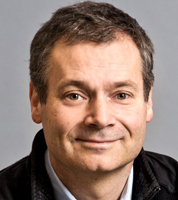Trickle-Down Sustainability — From Private Sector To Society

A Q&A with Johan Kuylenstierna, executive director of the Stockholm Environment Institute
By Julie King
For this second installment in a series of interviews conducted during SIWI World Water Week in Stockholm last month, I spoke with Johan Kuylenstierna, executive director of the Stockholm Environment Institute (SEI). Johan’s interests and work directly involves water issues. He holds an adjunct professorship in International Water Resources at the Dept. of Physical Geography and Quaternary Sciences at the Stockholm University. He also worked as the chief technical advisor to the chair of UN-Water, as well as project director at the Stockholm International Water Institute with overall responsibility for World Water Week in Stockholm prior to working at SEI.
How are research-focused civil society organizations like SEI working side-by-side with business, and how does SEI view the practical aspects of engaging the private sector?
 “In working with the private sector, our starting point in the discussion is ‘what drives developments within the private sector?’ — regardless if we work with the Swedish Steel Industry Confederation or the finance sector. Overall … we see the private sector as a very important actor in terms of reaching out with our research [to] instill change in society. The private sector is also key in terms of innovation and solutions. The private sector is a change-maker.
“In working with the private sector, our starting point in the discussion is ‘what drives developments within the private sector?’ — regardless if we work with the Swedish Steel Industry Confederation or the finance sector. Overall … we see the private sector as a very important actor in terms of reaching out with our research [to] instill change in society. The private sector is also key in terms of innovation and solutions. The private sector is a change-maker.
“Through collaboration and joint learning, we can provide our knowledge to influence their thinking, and support them too, as a way to drive positive change. The private sector is not just a recipient — it is also an important knowledge partner. We need to work with the private sector and harness the enormous amount of competence and experience that companies possess. Civil society organizations are not necessarily best suited to translate the value proposition of our research into a business case. The private sector has the competence, and mandate, to do this.”
As a civil society organization, how do you approach the idea of ‘sustainability’?
“My approach to sustainability is both environment and development-oriented. There are strong connections between environmental challenges and broader international development issues. The human drive for development should be at the center, and be regarded as an opportunity to find solutions to broader societal problems. I believe we must use ‘sustainability’ in a wider context, when we look at long-term social, environmental, and economic challenges of securing a healthy and prosperous life for 9 billion people. The changes you need to introduce must be done through society, with support of people. Therefore any sustainability strategy must place humans at the center of these goals.
“Positive change must start with an understanding of human development needs, as well as the opportunities to stimulate and support behavioral changes. We have to have a stronger ‘behavioral change’ understanding of what drives people … in order to drive change and to truly have sustainable development.”
How does SEI work with companies in terms of their sustainability or corporate social responsibility (CSR) strategies?
“When we engage with the private sector, as with other partners, we start by discussing and analyzing what sustainability challenges mean to them. Companies may have to change their approach to sustainability, and look at individual challenges more closely and how they relate to the broader picture.
“We are indeed experiencing that many companies are assessing on a more fundamental level, ‘What’s our role in society?’ and ‘How can we more fundamentally support a transformation to sustainability?’ Companies are beginning to consider fundamentally the role of different materials and products … in a sustainable society — and what [the role] will be in 50 years. The financial sector is beginning to do this, too. It has historically been a fundamental part of a well-functioning society, but will “sustainability” introduce new challenges and opportunities for them? What role will the financial sector have in 50 years? We don’t need to completely define what it will be in 50 years, but we need to have a general understanding and forward-thinking. There is a maturing discussion on such fundamental and almost existential issues within the private sector.
“I’m not terribly fond of CSR as an isolated issue to drive real change. It too often becomes an operation in itself, outside of the core business of the company. Corporations are part of society and need to integrate sustainability issues as part of their core business strategies and operations. Some argue that the most important thing a company can do to support sustainability is to pay taxes.”
What role can a civil society organization like Stockholm Environment Institute play for companies as a stakeholder in developing a project or business strategy?
“From a systems analysis perspective, we help companies understand what their challenges and opportunities are in a world undergoing rapid change, to fully understand what problems they face — i.e., with water in the broader context of their global supply chains or climate change. We engage with companies to help them understand indirect climate effects, like floods in Asia affecting supply chains and thus production facilities in the EU and elsewhere. It is essential to translate for example climate adaptation into business risks, but also possible solutions and actions.
“As many others, we’ve had a lot of work to do in this area [of stakeholder engagement], as a science-based organization. For example, how we can better communicate and increase the uptake of reports, papers, and policy briefs that we write and how we can further engage stakeholders in the scien[tific] process and projects.
“One of the recipes we use is to involve stakeholders from the beginning — to jointly identify the problems to be solved and discuss possible solutions. We have to understand the true challenges of the stakeholders’ in order to translate that to relevant research questions for SEI. We therefore work with stakeholders to define both the questions and outputs. It is also our job to try to link the outputs to relevant actors to ensure that the recipient sees benefits from our research. If we work with the stakeholders to do this, it is likely to be much easier to help solve their problems and then for them to find opportunities.
“There are often multiple benefits that can be identified if we see it in this way and understand the stakeholders’ capacity and adapt our language to them. This is a real ‘gap’ that has to be considered: language and accessibility.”
Top image credit: "Trickling Heart," © 2012 Andrew Tyson Thomson Photography license: http://creativecommons.org/licenses/by/2.0/deed.en
Johan Kuylenstierna image credit: Stockholm Environment Institute
